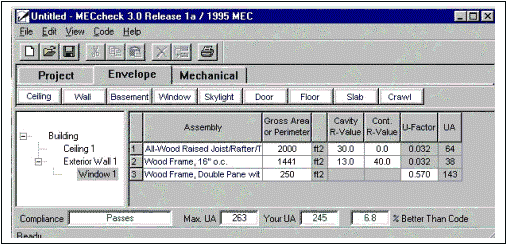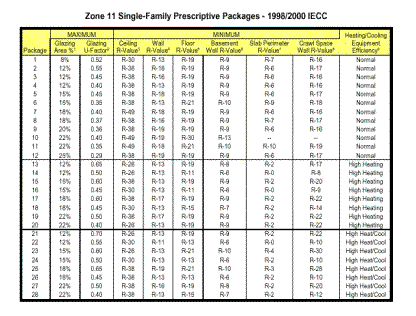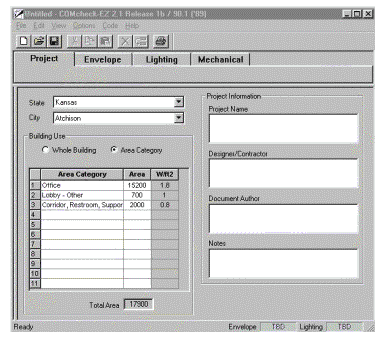Kansas State University
2323 Anderson Ave.
Suite 300
Manhattan, KS 66502
785-532-6026
Fax: 785-532-6952
engineeringext@k-state.edu
Building Energy Codes
Building energy codes introduction
Building energy codes establish minimum energy performance features in new residential and commercial buildings. Because most new homes are built to a building code, consumers assume their new building will be energy efficient. However, consumers are generally unaware of features and techniques needed to produce energy-efficient buildings and most new buildings do not meet minimum requirements of modern energy codes. Many builders are not aware of the levels of performance required to meet those standards.
Buildings, both homes and commercial structures, will endure for several generations. The single best opportunity to assure these building meet minimum levels of energy efficiency occurs during initial design and construction. Many energy performance features cannot cost-effectively be retrofitted at a later date. Failure to install certain features during construction dooms these structures to poor performance for life. Building energy codes help assure new buildings will be constructed to a minimum level of energy efficiency.
Minimum performance levels specified in energy codes are based on today's energy prices and construction costs. The impact of energy use from these buildings will increase as energy prices escalate and will be felt for years to come. Click on the bullets below to get a more detailed explanation of those issues.
Energy codes in Kansas
Commercial and High-Rise Residential Building Requirements
Kansas law requires that all new buildings, except low-rise residential buildings, comply with the International Energy Conservation Code - 2003 (IECC-03). Options in the IECC-03 allow the builder to either comply with Chapter 8 - Design by Acceptable Practice for Commercial Buildings, or they can comply with the American Society of Heating, Refrigerating, and Air-Conditioning Engineers Standard 90.1-2001 (ASHRAE 90.1-01)
Residential Building Code Requirements
Kansas law also requires that builders or sellers of previously unoccupied residential buildings, three stories or less height, certify the building either meets the residential requirements of the IECC-03, obtain a Home Energy Rating score of 80 or greater when performed in accordance with the Mortgage Industry National Home Energy Rating System Accreditation Standard (June 15, 2002) by a rater certified and listed by the Residential Energy Services Network (RESNET), or provide a list of energy performance features described on the Kansas Energy Disclosure form.
Cities or counties adopting energy codes
State law specifically allows for units of local government to adopt and enforce building energy standards. Many cities and counties have already or are in the process of adopting energy codes.
Obtaining copies of energy codes
To obtain a copy of:
|
|
Users Manual for ASHRAE Std 90.1-01 ASHRAE 1791 Tullie Circle, NE Atlanta, GA 30329 1-800-527-4723 |
|
|
ASHRAE Std 90.1-01 ASHRAE 1791 Tullie Circle, NE Atlanta, GA 30329 1-800-527-4723 |
|
|
International Energy Conservation Code ICBO 5360 Workman Mill Road Whittier, CA 90601 1-800-284-4406 |
Energy code compliance tools
Several tools have been developed to assist engineers, architects, and builders in complying with energy codes. These include REScheck and COMcheck tools described below. You can obtain these online at http://www.energycodes.gov/ or by calling 1-800-270-CODE.
Residential code compliance tools

The REScheck product group offers three simple ways to demonstrate compliance with the residential energy codes: the software approach, the prescriptive approach, and the prescriptive package generator. The following code rule sets are included in the REScheck products: 1992, 1993, 1995 MEC, or the 1998 or 2000 IECC.
The software approach uses a Windows-based tool that allows the builder to enter the area, R-values, and other energy details of the home. The software compares the building described to a building that just meets the code selected and reports how much better or worse the proposed building is as compared to a code-compliant building. Trade-offs between walls, windows, roofs, and equipment are all allowed. The software approach is the most flexible.

The prescriptive approach allows builders or designers to select from various combinations of energy conservation measures based on "climate zone" location. Each combination or "package" specifies insulation levels, glazing areas, glazing U-values (thermal performance), and sometimes heating and cooling equipment efficiency. By locating the correct climate zone and looking up the appropriate table of packages, builders and officials can ensure the project meets the requirements for that zone.
The prescriptive package generator allows builders or code officials to generate prescriptive packages that meet the code but incorporate building practices common in the community or area.
A detailed description of REScheck's capabilities and files for downloading can be found by calling 1-800-270-CODE.
The U.S. Department of Energy has prepared a guide for inspectors titled Inspecting for the Residential Provisions of the IECC .
Commercial code compliance tools

The COMcheck product group offers four simple ways to demonstrate compliance with the commercial energy codes: two software approachs, a prescriptive approach, and the prescriptive package generator..
COMcheck-EZ provides a flexible computer-based trade-off approach to commercial compliance. It contains rule sets for IECC-98, IECC-00, and IECC-01, as well as the ASHRAE 90.1-99. With simple instructions, extensive user help functions, and default libraries, the software is designed with ease-of-use as its primary objective.
COMcheck-Plus is a software tool developed to simplify the process of demonstrating compliance with the Std 90.1-89 commercial building energy code using whole-building (energy cost budget) performance methods. Using a wizard, you quickly model the key features of the building. The software compares the model building to a prototype building that would just meet the code.
A detailed description of COMcheck's capabilities and files for downloading by calling 1-800-270-CODE.
The ASHRAE User's Manual is the prime resource for understanding the details of ASHRAE Std 90.1-01. It includes detailed discussions of all sections of the standard including envelope, HVAC, lighting, service hot water, and the energy cost budget method of compliance.


